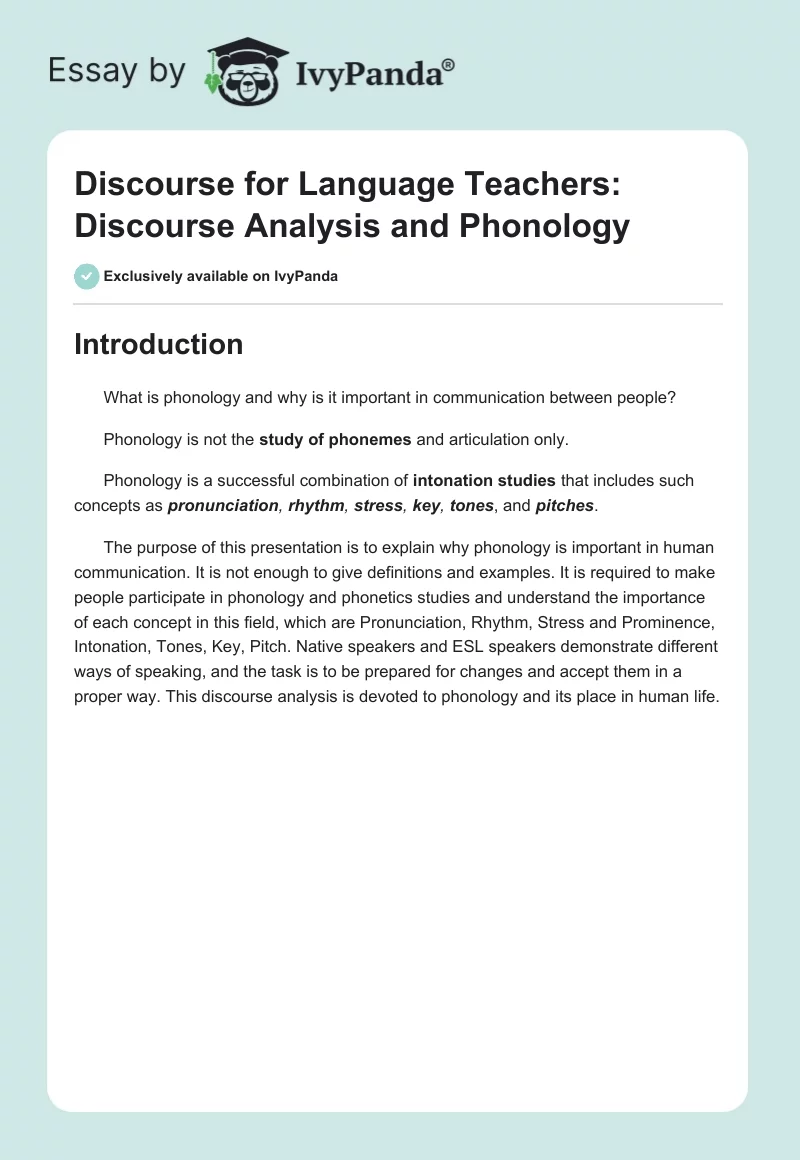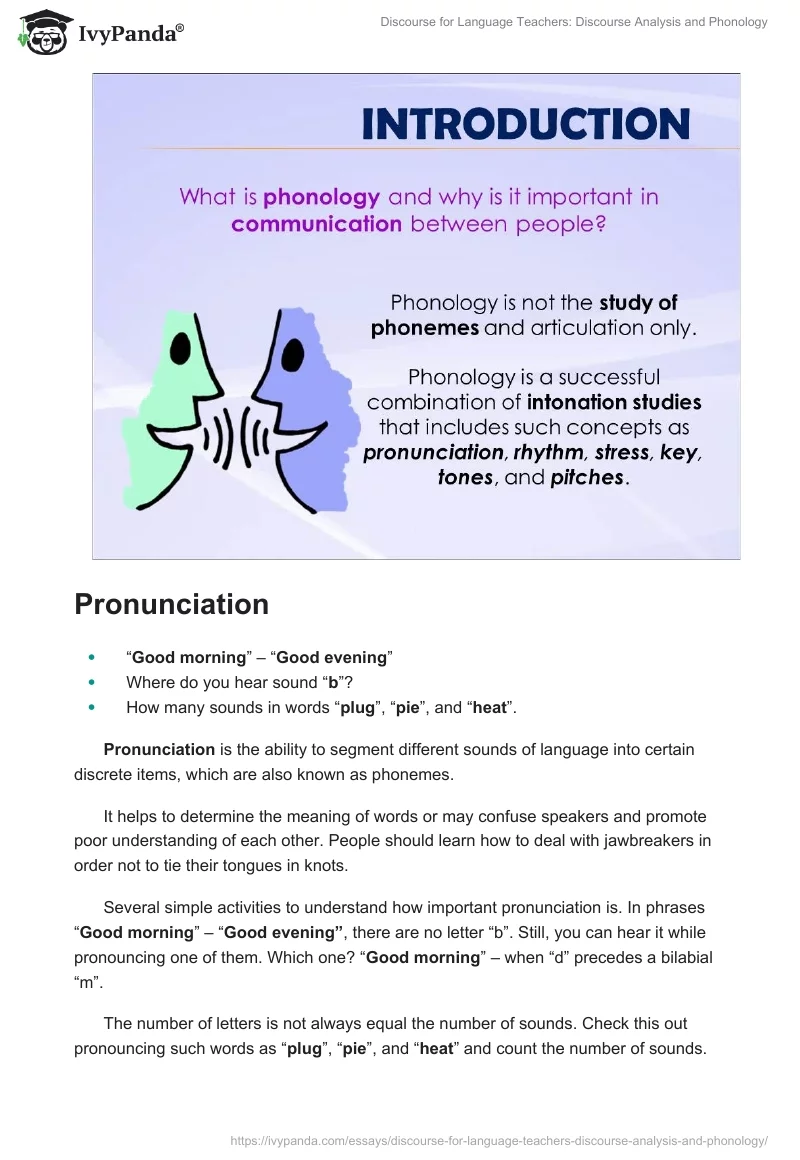Introduction
What is phonology and why is it important in communication between people?
Phonology is not the study of phonemes and articulation only.
Phonology is a successful combination of intonation studies that includes such concepts as pronunciation, rhythm, stress, key, tones, and pitches.
The purpose of this presentation is to explain why phonology is important in human communication. It is not enough to give definitions and examples. It is required to make people participate in phonology and phonetics studies and understand the importance of each concept in this field, which are Pronunciation, Rhythm, Stress and Prominence, Intonation, Tones, Key, Pitch. Native speakers and ESL speakers demonstrate different ways of speaking, and the task is to be prepared for changes and accept them in a proper way. This discourse analysis is devoted to phonology and its place in human life.
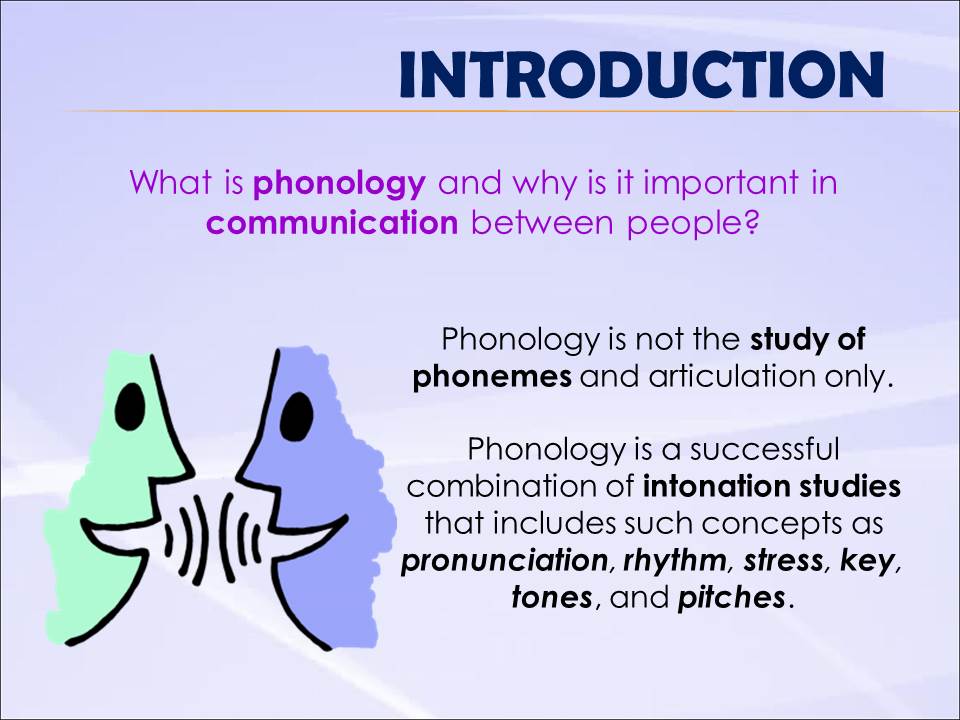
Pronunciation
- “Good morning” – “Good evening”
- Where do you hear sound “b”?
- How many sounds in words “plug”, “pie”, and “heat”.
Pronunciation is the ability to segment different sounds of language into certain discrete items, which are also known as phonemes.
It helps to determine the meaning of words or may confuse speakers and promote poor understanding of each other. People should learn how to deal with jawbreakers in order not to tie their tongues in knots.
Several simple activities to understand how important pronunciation is. In phrases “Good morning” – “Good evening”, there are no letter “b”. Still, you can hear it while pronouncing one of them. Which one? “Good morning” – when “d” precedes a bilabial “m”.
The number of letters is not always equal the number of sounds. Check this out pronouncing such words as “plug”, “pie”, and “heat” and count the number of sounds. Plug – 4 letters and 4 sounds; Pie – 3 letters and 4 sounds; Heat – 4 letters and 3 sounds.
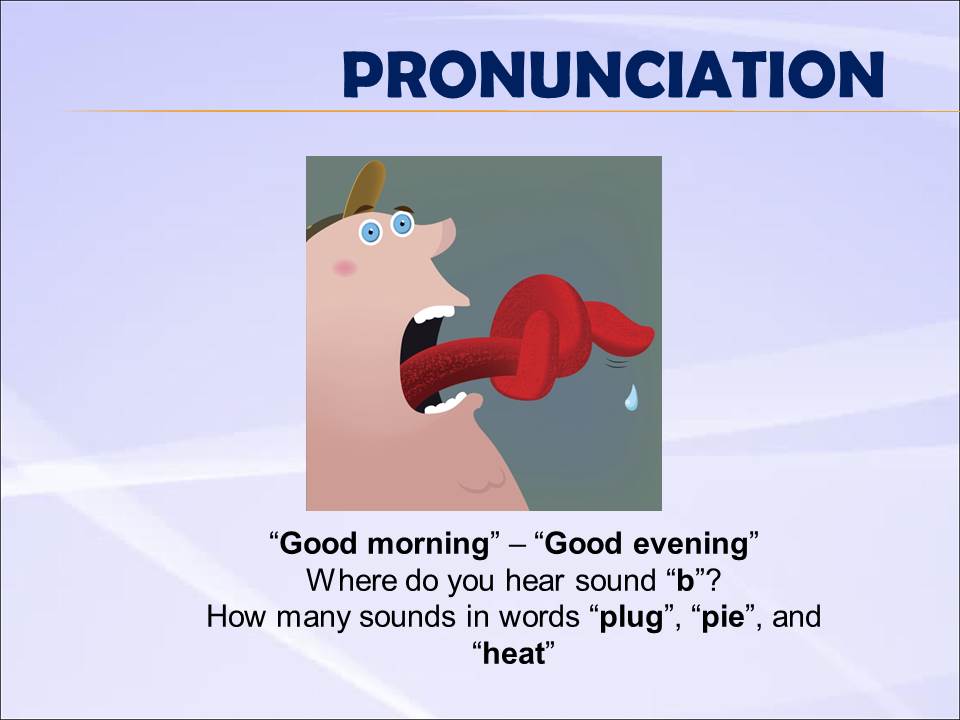
Rhythm
Rhythm in English:
- Rhythmicality;
- Stress-timed language.
Rhythm is a regulation of sounds that promotes certain characteristics which differ in languages. It is a crucial element in the teaching of spoken English. There are two main factors that help to consider rhythm as a significant element of education:
- English is characterised by rhythmicality that varies in different stretches of speech.
- English is a stress-timed language.
To understand the presence of rhythm, try to read the following sentences and clarify where strong and weak “beats” occur and why?

Stress and prominence
Stress: Degree of force in syllable production.
Prominence: Syllables which are found out in the flow of talk due to the necessity to utter them.
Interactive choice is appropriate
Stress and prominence cannot be neglected in speaking. People should understand how to underline the importance of one letter or sound, and when it is necessary to utter something. However, theory is not enough for understanding these concepts. Stress and prominence have to be practiced a lot. Though the last element of word or phrase should usually be uttered, there are the situations when different parts may be stressed. When people investigate stress and prominence, they prefer to use interactive choice.
- Stress: Occasional. Pedestrian. Electronic.
- Prominence: Mediterranean climate, Satisfactory results, Independent girl.
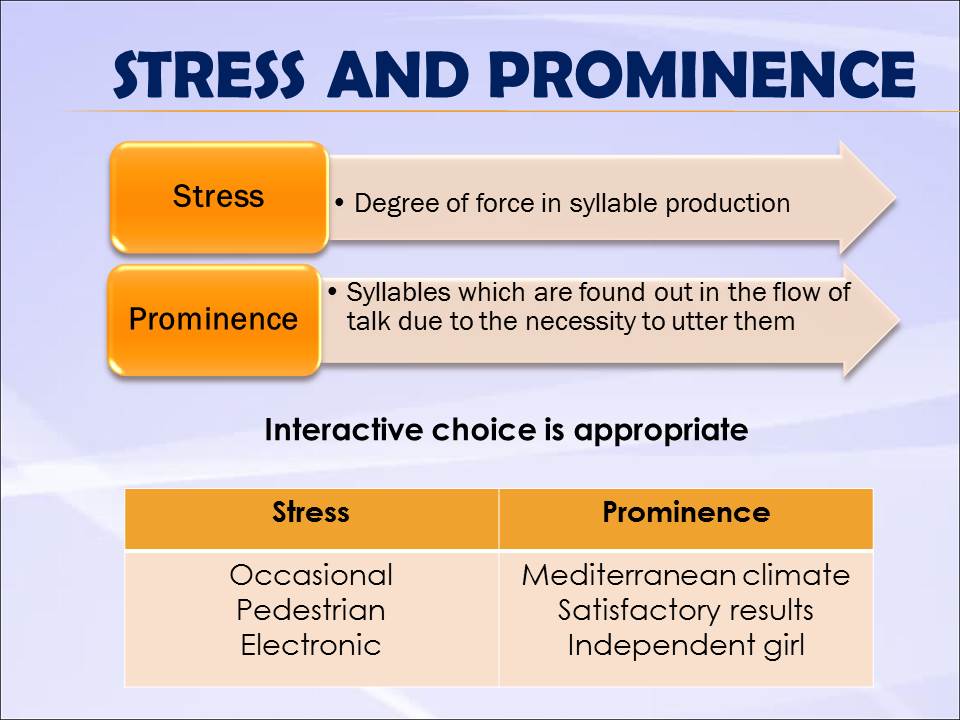
Intonation
- Intonation determines the meaning of a message.
- It helps to differentiate sarcasm, teasing, or surprise.
Intonation is a useful tool for communication because it helps to determine the message and comprehend its quality and possible impact. People know that the way they speak to each other may change the direction in a short period of time and establish a new attitude. People’s phrases may be full of sarcasm, surprise, or teasing. Intonation aims at identifying those.
There are many intonational units, which are also known as tone units or tone groups. These groups create a strong basis for the analysis of conversation.
Look at the phrases and try to develop the situations when the same words may gain different meanings:
- Finally, you’ve come! – expectation, disappointment, hope.
- I cannot understand you at all. – ask for help, frustration, anger.
- Just observe what he is doing! – admiration, wonder, surprise.
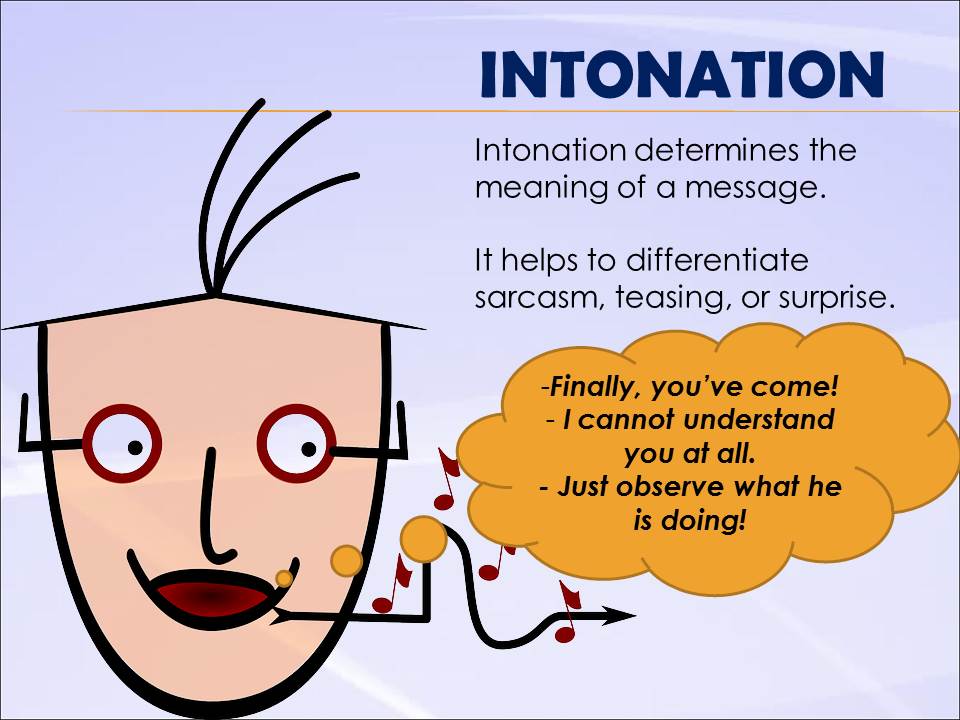
Tones
Tone is a type of intonation with a certain grammatical function.
Types of tones:
- Where can I find Tom?
- Do you see him?
- Would you like to date him?
- Are you angry?
- I like to have it.
Tones are used to express emotions, attitudes, moods alongside with non-verbal behaviuor, lexis, and intonation/
Tone is the way people say something. It is possible to sound neutral and stick to a level tone where no emotions or attitudes are express. In interrogative or exclamatory sentences, tone may gain different directions from fall or fall-rise to rise or rise-fall. The choice of tone is the possibility to share a mood or an attitude to something. In other words, intonation gains a grammatical function. Though certain pedagogical complications occur while studying and explaining tones, the role of emotions in such interactive approach cannot be neglected.

Key
A relative level of pitch that can move from one utterance to another and jump upwards to provide a phrase with a meaning.
Types of keys:
- HIGH – Do you trust that man in here?
- LOW – I do not trust that man but myself.
- MID – That is a good answer.
Key is a significant phonological unit that helps to create strong sentences and exchange thoughts in a clear way. They can be changed and be interchangeable in regards to the intentions of speakers. There are three types of key that may be used in speeches:
- High keys promote initiation, expectation, or surprise that cannot be predicted or causes wonder.
- Low keys show an ending of thought, a statement of fact, or a clarification of an idea.
- Mid keys are used in the middle of the average of pitch range and prove that a process is ongoing.

Pitch
Four Rules of Pitch in Speaking:
- Pitch-level choices matter in communication.
- Concord in pitch is the phenomenon in phonology.
- Speaker’s choice cannot be neglected.
- Participants may change roles in communication.
There are four main rules about pitch and its levels that have to be remembered by speakers:
- Pitch-level choices matter in communication – Speakers can deliver their messages faster in case they choose an appropriate level of pitch.
- Concord in pitch is the phenomenon in phonology – In one phrase, there can be one-level pitch or several levels to prove the intentions of a speaker.
- Speaker’s choice cannot be neglected – There are no specific rules on how to make a choice of a pitch level. A speaker is the one who makes this decision.
- Participants may change roles in communication – There is no person who should follow speeches and determine mistakes. Speakers are independent participants who are free to change their roles and improve communication.


